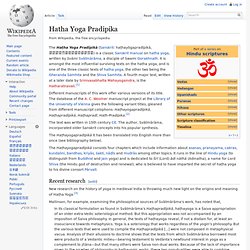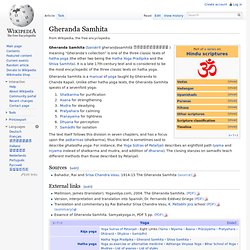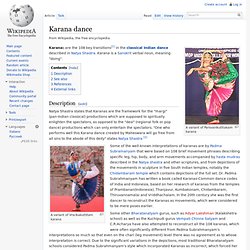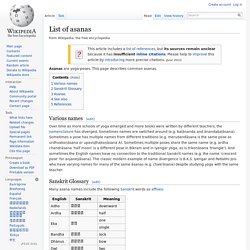

Shiva Samhita. Shiva Samhita śivasaṁhitā (also Siva Samhitā) is a Sanskrit text on yoga, written by an unknown author.[1] The text is addressed by the Hindu god Shiva to his consort Parvati ("Shiva Samhita" means "Shiva's Compendium").

Hatha Yoga Pradipika. The Haṭha Yoga Pradīpikā (Sanskrit: haṭhayōgapradīpikā, हठयोगप्रदीपिका) is a classic Sanskrit manual on hatha yoga, written by Svāmi Svātmārāma, a disciple of Swami Gorakhnath.

Gheranda Samhita. Gheranda Samhita (Sanskrit gheraṇḍasaṁhitā घेरंडसंहिता ) meaning “Gheranda's collection” is one of the three classic texts of hatha yoga (the other two being the Hatha Yoga Pradipika and the Shiva Samhita).

It is a late 17th-century text and is considered to be the most encyclopedic of the three classic texts on hatha yoga. Gheranda Samhita is a manual of yoga taught by Gheranda to Chanda Kapali. Unlike other hatha yoga texts, the Gheranda Samhita speaks of a sevenfold yoga: Shatkarma for purificationAsana for strengtheningMudra for steadyingPratyahara for calmingPranayama for lightnessDhyana for perceptionSamādhi for isolation The text itself follows this division in seven chapters, and has a focus upon the ṣaṭkarmas (shatkarma), thus this text is sometimes said to describe ghatastha yoga. Sources[edit] Bahadur, Rai and Srisa Chandra Vasu. 1914-15 The Gheranda Samhita (source) External links[edit] Mallinson, James (translator). Yoga.
Yoga (/ˈjoʊɡə/; Sanskrit: योग, Listen) is an Indian physical, mental, and spiritual practice or discipline.

There is a broad variety of schools, practices and goals in Hinduism, Buddhism (including Vajrayana and Tibetan Buddhism[2][3][4]) and Jainism.[5][6][7][6] The best-known are Hatha yoga and Raja yoga. The origins of Yoga have been speculated to date back to pre-Vedic Indian traditions, but most likely developed around the sixth and fifth centuries BCE, in ancient India's ascetic circles, which are also credited with the early sramana movements. [note 1] The chronology of earliest texts describing yoga-practices is unclear, varyingly credited to Hindu Upanishads[9] and Buddhist Pāli Canon,[10] probably of third century BCE or later. The Yoga Sutras of Patanjali from first half of 1st millennium CE is one of a key surviving major texts on Yoga.[11][12] Hatha yoga texts emerged around 11th century CE, and in its origins was related to Tantrism.[13][14] Terminology. Karana dance.
A variant of Parsvanikutttakam karana Karanas are the 108 key transitions[1] in the classical Indian dance described in Natya Shastra.

Karana is a Sanskrit verbal noun, meaning "doing". Description[edit] Natya Shastra states that Karanas are the framework for the "margi" (pan-Indian classical) productions which are supposed to spiritually enlighten the spectators, as opposed to the "desi" (regional folk or pop dance) productions which can only entertain the spectators. "One who performs well this Karana dance created by Maheswara will go free from all sins to the abode of this deity" states Natya Shastra [2] A variant of Vrscikakuttitam karana While recently there used to be devadasis who perform all the 108 karanas, in most contemporary Bharatanatyam or Odissi schools only a small number of karanas and their derivatives have been transmitted by parampara up to date.
Apart from that, performing of the same karana differ greatly across different classical Indian styles. List of asanas. Asanas are yoga-poses.

This page describes common asanas. Various names[edit] Over time as more schools of yoga emerged and more books were written by different teachers, the nomenclature has diverged. Sometimes names are switched around (e.g. balānanda and ānandabalāsana). Sometimes a pose has multiple names from different traditions (e.g. merudandāsana is the same pose as urdhvakoṇāsana or upaviṣṭhakoṇāsana A). Asana. In the practice of Yoga, Asana denotes the art of sitting still[1] and also any posture useful for restoring and maintaining a practitioner's well-being and improving the body's flexibility and vitality, cultivating the ability to remain in seated meditation for extended periods.[2] Such asanas are known in English as "yoga postures" or "yoga positions".

Any way that we may sit or stand is an asana while a posture used in yoga is called a yogasana. Modern usage includes lying on the back, standing on the head and a variety of other positions.[2] In yoga asana refers both to the place in which a practitioner (yogin or yogi if male, yogini if female) sits and the posture in which he or she sits.[3] In the Yoga Sutras, Patanjali defines asana as "to be seated in a position that is firm, but relaxed".[4] Patanjali mentions the ability to sit for extended periods as one of the eight limbs of his system, known as Raja yoga,[5] but does not reference standing postures or kriyās.